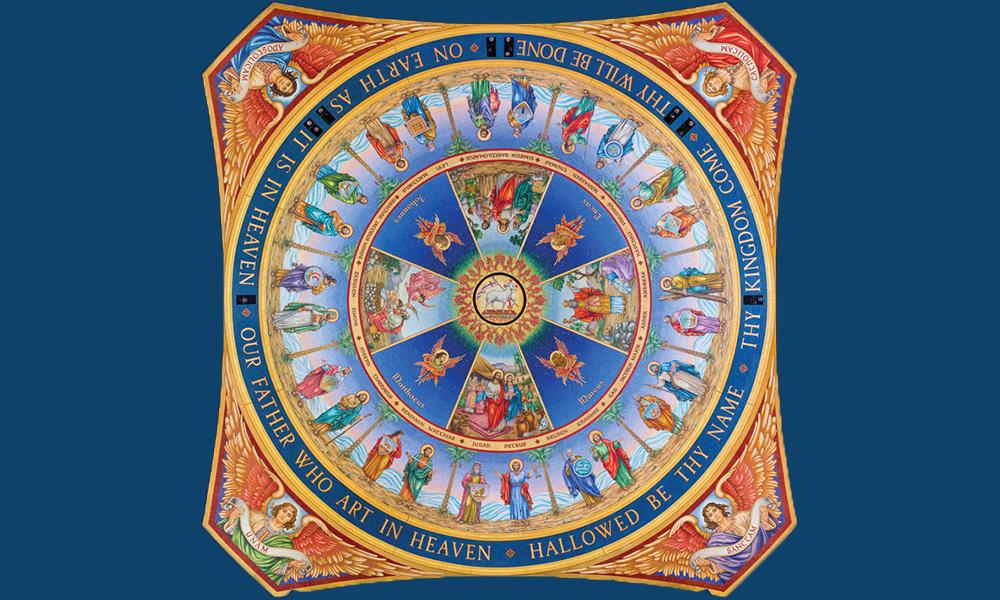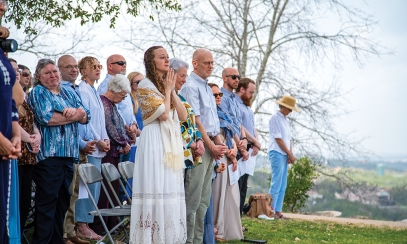
Dome Brings to Life the Fullness of the Body of Christ
On my good days, when I am driving to church, I consider myself in a procession with others who are going to Mass. I don’t turn on the radio. I don’t make phone calls. I pray to be mindful of where I am going and why I am going there. I consider all places and all things sacred, but when I go to church, I know this is a sacred space different from others. This Domus Dei, house of God, is where I will gather with others as the Body of Christ to enter the fullness of the liturgy. We use the phrase “angels, martyrs and saints” to remind us of the fullness of history and the range of this timeless Body of Christ. One space in our diocese where this is directly depicted in its art is St. John Neumann Parish in Austin.
On my good days, when I am driving to church, I consider myself in a procession with others who are going to Mass. I don’t turn on the radio. I don’t make phone calls. I pray to be mindful of where I am going and why I am going there. I consider all places and all things sacred, but when I go to church, I know this is a sacred space different from others. This Domus Dei, house of God, is where I will gather with others as the Body of Christ to enter the fullness of the liturgy. We use the phrase “angels, martyrs and saints” to remind us of the fullness of history and the range of this timeless Body of Christ. One space in our diocese where this is directly depicted in its art is St. John Neumann Parish in Austin.
As one enters the sanctuary, you are drawn forward by colorful tiled images in the floor. As you look up, you see the altar and crucifix ahead, and as your eyes continue looking up, the earth tones change to the brilliant, jeweled tones of the magnificent mosaic tile dome towering over five stories high, representing the Heavenly realm.
In the center of the dome is the Lamb of God, surrounded by 12 seraphim and 12 cherubim. The inner ring has the traditional depictions of the Evangelists — Matthew as a man, Mark as a lion, Luke as a bull and John as an eagle. Signifying the Old Testament are panels of the sacrifice of Isaac by Abraham and the sacrifice of Melchizedek. For the New Testament, there are panels of the miracle of the loaves and fishes and the wedding at Cana.
The outer ring depicts the 12 Apostles (holding the instruments of their martyrdom or a symbol of their role or ministry), each standing next to the patriarchs of the 12 tribes of Israel (who hold shields bearing the symbols connected to their tribes). The very outermost ring is the Lord’s Prayer. The four “corners” of the dome, called pendentives, depict angels holding banners with the Latin words for one, holy, Catholic and apostolic. Below it are the stations of the cross.
Neither words nor pictures can do justice to the sense of place and beauty one feels while standing in this sanctuary, but I detailed the treatment of the dome for a reason. The Old Testament and New Testament provide a container, a wider worldview, if you will, for those of us in the present who are continuing the relationship that is represented in the art. We are women, men and children continuing the story of God in our lives, through our liturgies, as well as our daily routines.
The stories depicted in the mosaic live on in the people sitting in the pews. It was a community of strong faith that called for the creation of this beautiful art, and now this sacred art continues to call forth a strong faith. Its beauty will move us to worship, surrounding us in the relationship and timelessness that is the Body of Christ.
Mark Landers is a parishioner of St. Austin Parish in Austin and a member of the Diocesan Fine Arts Council. He and his wife, Christina, own and operate Landers’ Studio, a woodworking shop and design studio. They design and construct custom furniture and high-quality architectural piecework.



